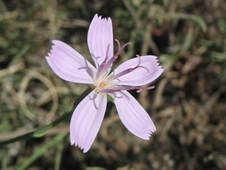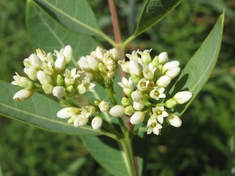 Found in dry areas, rocky slopes, open woodlands Seen blooming on June 24, 2018 in Abiquiu Prickly Pear grows to 20” hugging the ground in low clumps. Flowers can be lemon yellow, orange or pink and often have reddish centers. Pads are oval in shape, up to 10" long, with widely-spaced brown-tipped spines. There are numerous minutely barbed hairs at the base of the spines that are easily dislodged when the plant is touched and can become stuck to the skin where they are difficult to see and remove. The fruits are red to purple, without spines. The fruit is edible and is eaten fresh or dried, made into jams, jellies, juice and wine; pads are also edible and are prepared by roasting, boiling, or pulping and making into cakes; the seeds are ground into flour. The juice of the boiled stem segments is very sticky. It is added to plaster, whitewash etc. to make it adhere better to walls. Source. If you want to identify a different flower then you might find it useful to check what was blooming this time last year. If you cannot identify a flower from the website send a photo and where you took it to [email protected]. Read online for tips.
0 Comments
 Brownplume Wirelettuce, Prairie Skeletonp lant, Fewflower Wirelettuce, Desert Straw Stephanomeria pauciflora Sunflower Family (Asteraceae) Found in gravelly and sandy soil in canyons Seen blooming on June 18, 2018 in Red Wash Canyon Grows to 2 feet high with twisted, angled, bluish-green stems and sparse leaves. The pinkish-purplish flowers are ¾" across with toothed petals and purple stamens. The Hopi used it to increase mother's milk supply while the Navajo considered it a narcotic and used it to hasten delivery of the placenta, in paint ingredients for arrows and chewed the root like gum. Source. If you want to identify a different flower then you might find it useful to check what was blooming this time last year. If you cannot identify a flower from the website send a photo and where you took it to [email protected]. Read online for tips.  Indian Hemp, Dogbane Hemp, Prairie Dogbane, Rheumatism Root Apocynum cannabinum Dogbane Family (Apocynaceae) Found in gravelly and sandy soil by roadsides, ditches, stream sides Seen blooming on June 11, 2018 in Arroyo Trujillo Indian Hemp grows to 3 feet tall in erect clumps with a smooth red stem which contains a milky latex that can cause blisters. Tiny white flowers are urn-shaped and produce 8" long seed pods. Apocynum in the scientific name means "poisonous to dogs". All parts of the plant are poisonous. The cannabinum refers to its similarity to cannabis as a fiber plant, hemp, rather than as a source of a psychoactive drug. A very good quality fiber obtained from the bark is used for making clothes, twine, bags, linen, and paper. It is an unpleasantly bitter stimulant irritant herb that acts on the heart, respiratory and urinary systems, and also on the uterus. North American Indian tribes used it to treat a wide variety of complaints including rheumatism, coughs, pox, whooping cough, asthma, internal parasites, diarrhea, and to increase milk flow in lactating mothers. The plant is still used in modern herbalism, but it should be used with great caution. Source. If you want to identify a different flower then you might find it useful to check what was blooming this time last year. If you cannot identify a flower from the website send a photo and where you took it to [email protected]. Read online for tips. |
AuthorI am Marilyn Phillips, a native of England, whose love of nature and the outdoors from childhood brought me by a circuitous route to Crested Butte, Colorado in 1993 and 16 years later to northern New Mexico. My exploration of the many trails in these areas, my interest in wildflowers and photography, and career in computer system design came together in this creation. If you have any corrections, comments or questions, please contact me by email. Archives
September 2025
Categoriescopyright © 2020
|


 RSS Feed
RSS Feed